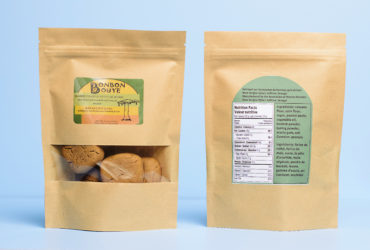Pesky Pesticides: Cranberries in Crisis
By Eleanore Hansen
The Great Cranberry Scare of 1959
Cranberries are a staple on the plates of many Americans during the fall and winter holidays. Their presence is practically ubiquitous, and who could forget the lovable Linda Belcher of Bob’s Burgers singing her signature Thanksgiving song, “pass the cranberry sauce; we’re having mashed potatoes”? But for many families in 1959, cranberries were quickly crossed off of the menu.
On November 9th, 1959, the United States Secretary of Health, Education, and Welfare, Arthur Flemming, decried cranberries and declared that they had been tainted with an herbicide that had been alleged to cause cancer. While the federal governments’ hundred inspectors found only a small amount of contamination in a few cranberries from Washington and Oregon, the damage had been done.[1] Many grocery stores had been wiped clean of their cranberry stock, as few families wanted to serve contaminated cranberries, especially since the contaminant was suspected to cause thyroid cancer.
This was the beginning of what is now known as The Great Cranberry Scare of 1959. Though just 10% of the cranberry crop was contaminated, this represented the first food scare since the days of The Jungle by Upton Sinclair, the 1906 novel which is largely credited with being responsible for the shift in food safety awareness and regulation in the United States. Cranberries were canceled. Cancer was too great a risk for consumers to chance, especially with the limited options for medical care at the time. Prevention was the best practice. While the cranberry industry did ultimately recover over time, the economic burden of reduced sales resulted in small producers losing their cranberry bogs, closure of cranberry packing plants, and large layoffs in cranberry-producing companies.[2] What weed-killer was responsible for so much cranberry chaos? Amitrole.
3-Amino-1,2,4-triazole, also known as aminotriazole or amitrole, is an herbicide that was first registered with the U.S. Environmental Protection Agency (EPA) in 1948. Early rat studies indicated that the herbicide may be causing thyroid tumors in various types of rats, and the herbicide was not used for food applications. Even today, the U.S. EPA does not have a tolerance level for amitrole in food products.[3] This means that any amount of amitrole in cranberries today would still be considered an adulterant (contaminant) that violates our current food safety regulations, though amitrole does have other applications in agriculture.
So… Can Amitrole-Tainted Cranberries Give You Cancer?
The short answer? No, probably not. Now for the long answer… While various studies over the past several decades have shown that amitrole may cause cancer in rodents such as rats, mice, and golden hamsters, many of these studies are outdated and have serious design concerns. When the International Agency for Research on Cancer (IARC) assessed amitrole in 2001, the group responsible for reviewing the rodent studies noted that many of the early reports lacked detail and did not have appropriate control animals to compare with the animals being administered amitrole. Despite this, other studies with better design did give some indication of carcinogenic potential in rodents.
While potential for a pesticide to cause cancer in animals may sound concerning, the evidence of thyroid cancer, or any cancer for that matter, in humans being associated with amitrole is nearly nonexistent at this time. Studies that followed workers that sprayed or prepared amitrole did not uncover any evidence of thyroid damage or change in thyroid function in the days and weeks following. Additionally, a study of rail workers in Sweden exposed to amitrole for over 45 days did not observe any increase in cancer over 20 years of follow-up. Another significant finding that IARC noted was that amitrole did not cause DNA damage in mammalian cells or in live rodents, further suggesting that it is unlikely to cause cancer in humans, at least not by damaging DNA (a common pathway of cancer formation).
All in all, IARC determined that there is inadequate evidence that amitrole causes cancer in humans, but there is sufficient evidence that amitrole causes cancer in some animals, giving it a categorization of “not classifiable as to its carcinogenicity to humans (Group 3)”. This doesn’t mean it’s considered fully ruled out as a human carcinogen, but the group of reviewers noted that there is not strong evidence in humans at levels that don’t alter thyroid hormone balance. The group concluded that the evidence from rodents suggested that rodents are more sensitive to developing thyroid tumors when exposed to a compound that disrupts their thyroid hormone balance, in this case, amitrole.[4] Of course, there could still be some risk, but most of us will never encounter amitrole at concerningly high levels, especially not in our food.
Have a Very Merry Cranberry Christmas
Follow Linda’s lead: go ahead and pass the cranberry sauce this year at your holiday feast. While amitrole proved a pesky pesticide in 1959, it is not currently a cranberry concern. The Great Cranberry Scare, like many other pesticide scares in the history books, is an iconic moment in food safety history for the United States. It sent fear swirling through the nation right before a time when families and friends expected to come together and enjoy good food and company, and temporarily crippled cranberry producers. Although we now know that the amitrole-tainted cranberries were relatively few, and that they wouldn’t have caused much harm, they serve as a cautionary tale for food producers and consumers alike…unsafe food can taint Thanksgiving and crush Christmas spirit. Keep food safety in mind this holiday season as you prepare your repast.
[1] Gov’t Inspectors Test Cranberries All Over U.S. (1959, November 11). The Telegraph, p. 7.
[2] Landrigan, L. (2021, November 20). The Great Cranberry Scare of 1959 Wreaks Havoc at Thanksgiving. New England Historical Society. https://www.newenglandhistoricalsociety.com/the-great-cranberry-scare-of-1959-wreaks-havoc-at-thanksgiving/
[3] United States Environmental Protection Agency. (1996). Amitrole. R.E.D. Facts. https://www3.epa.gov/pesticides/chem_search/reg_actions/reregistration/fs_PC-004401_1-Sep-96.pdf
[4] IARC. (1996). Some Thyrotropic Agents. pp. 381-410. https://publications.iarc.fr/Book-And-Report-Series/Iarc-Monographs-On-The-Identification-Of-Carcinogenic-Hazards-To-Humans/Some-Thyrotropic-Agents-2001
 About the Author:
About the Author:
Eleanore Hansen is a second year PhD student studying toxicology in the Division of Environmental Health Sciences in the School of Public Health at the University of Minnesota. She got dual BS degrees in Food Science and Chemistry at the University of Illinois at Urbana Champaign, and her MS in Food Science with an emphasis on food safety and microbiology at the University of Minnesota. She is thrilled to begin her second semester of teaching a course on food safety, risks, and technology at the University of Minnesota in spring 2023.






Leave a Reply